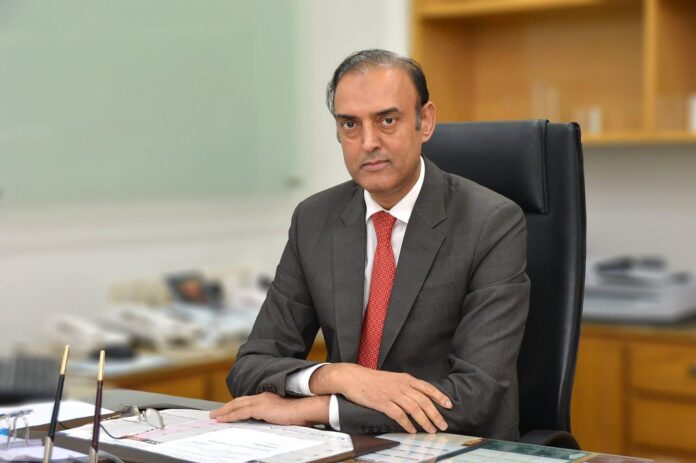LAHORE: The governor of the State Bank of Pakistan (SBP) has said that banks need to lend support to the agricultural sector in the wake of the devastating floods that hit the country this year.
Chairing the meeting of the Agricultural Credit Advisory Committee (ACAC), Governor Jameel Ahmad said that climate change is the biggest long-term threat to the country due to its unforeseen impacts.
He added that while the government, businesses and societies are recognizing such threats, we need to take timely actions and allocate required resources for research and development of relevant products and services and capacity building of stakeholders to address them preemptively.
Agriculture financing in Pakistan
According to a central bank report from last year, 90-94 per cent of farm loans are offered for production and only 6-10pc for agricultural development. The share of development loans in total agricultural finance stood at 6pc in 2018-19. This percentage improved to 6.7pc in 2019-20 and further to 10pc in the first seven months of this fiscal year.
On top of this, almost 84% of farmers in the country comprise small farmers and rely on informal sector credit at exorbitant rates to meet their agri. credit requirements. One of the main reasons for the financial exclusion of these small farmers has been their inability to provide collateral to banks. Most agricultural loans provided in the country are hard loans — which means that banks require collateral in exchange for securing the loan. Since farmers rarely own the land they work on, this is an uphill climb for them.
Governor’s remarks
Speaking during the ACAC meeting in Hyderabad, Governor Ahmed appreciated the country’s banks for achieving unprecedented agriculture credit disbursement of Rs1,419 billion in FY22. He noted that for FY23, a target of Rs1,819 billion has been set in line with the Government’s priority and added that during the first five months of FY23, Rs 664 billion have already been disbursed.
“The prime minister has announced the Kissan Package, comprising of restructuring and rescheduling of agriculture loans, mark-up waiver for outstanding small loans in flood affected areas, interest-free loans for subsistence & landless farmers and subsidized loans and risk sharing scheme for farm mechanization, besides other support measures”, he said.
The governor elaborated that the package will facilitate recovery of farmers from the impact of recent floods and urged banks to implement the package in letter and spirit. He also assured SBP’s full support to the banks wherever needed.
The Governor also underlined that banks have a huge opportunity to exploit the untapped potential of Islamic agriculture financing with respect to SBP’s recent commitment towards transformation of conventional banking to Islamic banking in the next five years. He noted that the share of Islamic financing in agriculture financing is still quite low and urged the industry to work on developing demand driven Islamic financing products, specifically tailored to the requirements of the farming community.
The governor’s inaugural address was followed by a presentation on the performance of banks in agricultural financing. The ACAC deliberated on the new directions in agricultural financing particularly regarding climate smart agriculture practices and the role that financial institutions can play. Moreover, the champion banks, nominated by the ACAC to spearhead the efforts in underserved areas, presented the progress in their respective assigned underserved provinces or regions.
Threat from climate change
This year’s floods have illustrated more than anything the impact of climate change in Pakistan, and more importantly the devastating threat it poses to Pakistan’s agriculture, livestock, and consequently food security.
In short, climate change has resulted in a gargantuan increase in the amount of monsoon rainfall that Sindh and Balochistan have seen this year. The two provinces saw the highest amount of water fall from the skies in living memory, recording 522% and 469% more than the normal downpour this year according to the met department.
All in all, according to the latest report of the Post-Disaster Needs Assessment (PDNA), Pakistan needs at least $16.3 billion for post-flood rehabilitation and reconstruction. The PDNA report, released by the representatives of the government and the international development institutions, calculated the cost of floods at $30.1 billion – $14.9 billion in damages and $15.2 billion in losses.
The problem with this, of course, is that even if these funds come through from the international community in the form of soft loans, aid, or reparations, the small-scale farmers mentioned earlier in the report may not benefit from them.
“Pakistan faces a problem where even if it is given the climate financing that it is asking for, it will not know how to spend this money effectively. It is not a question of financing but of governance. Just look at what you need to be spending money on”, says Ali Sheikh, an expert on climate change and development.
“You need it for research and development. The losses that have been calculated are all infrastructural, but there is very little attention that has been paid to more long-term solutions. Losses in agriculture are becoming more and more severe and predictable for example but they continue to happen every single year”.





this is really nice to read..informative post is very good to read..thanks a lot!
Thanks for taking the time to discuss this, I feel strongly about it and love learning more on this topic.
I found the information provided in this post to be highly relevant and current, making it a valuable resource for industry professionals.